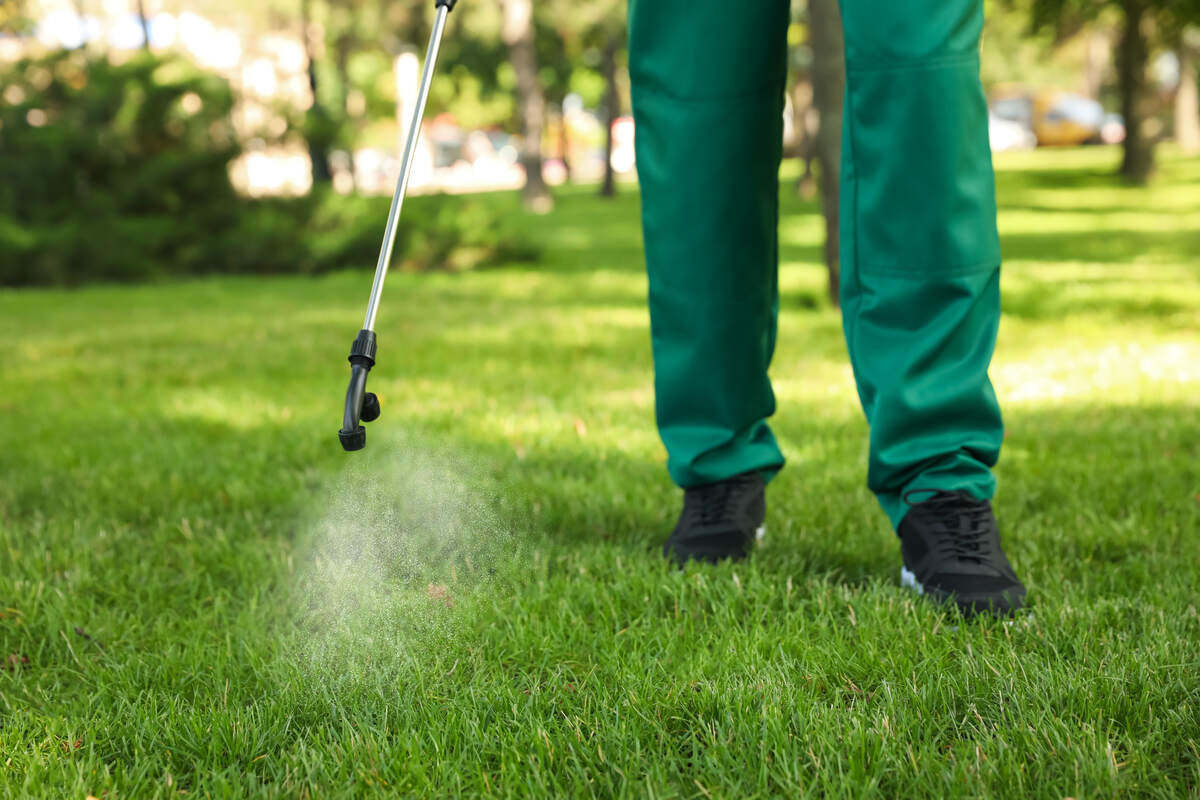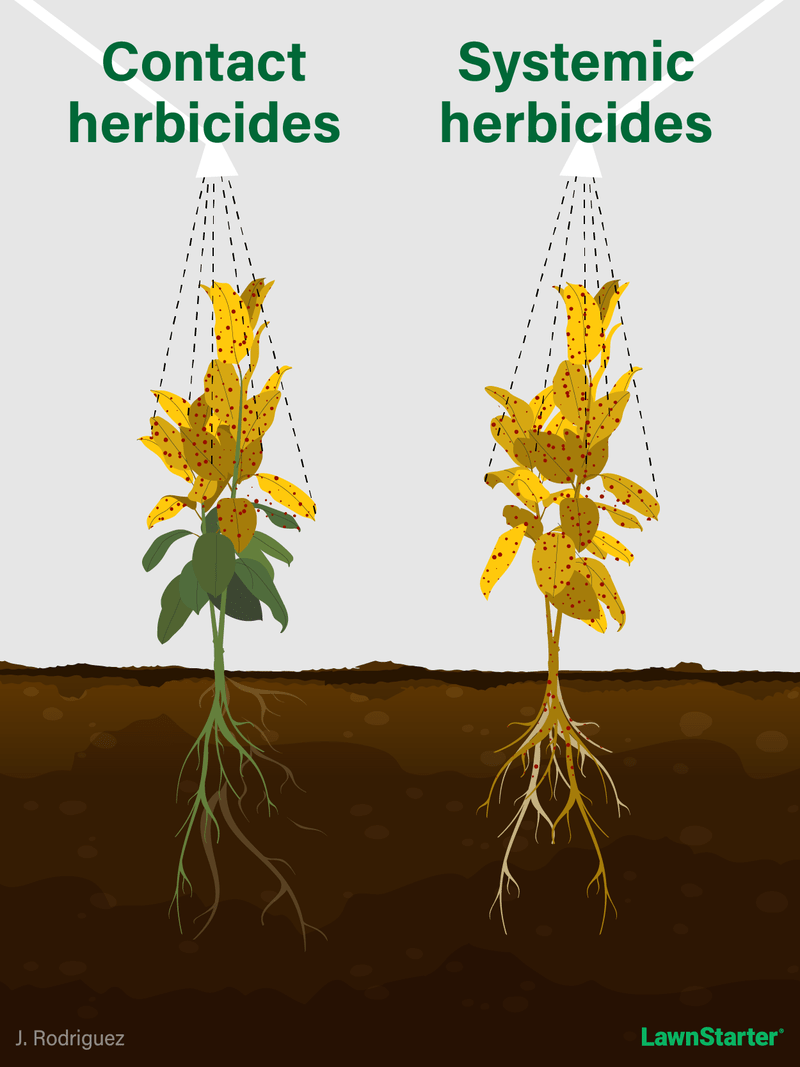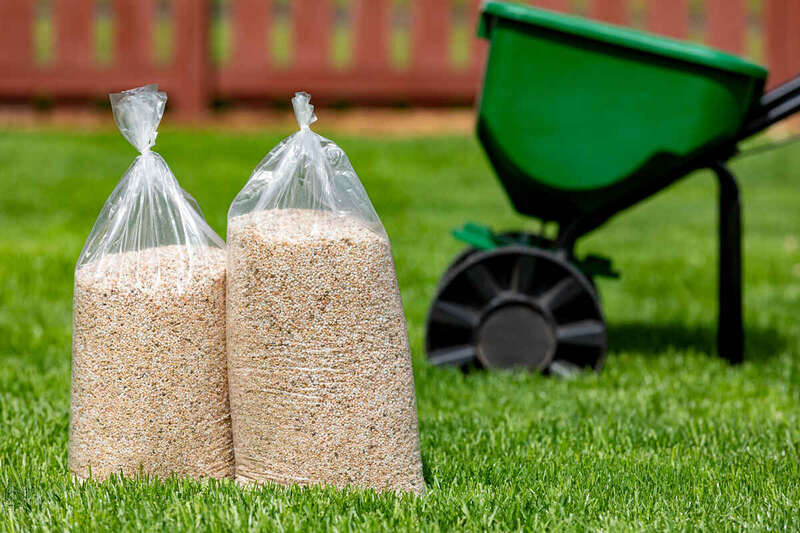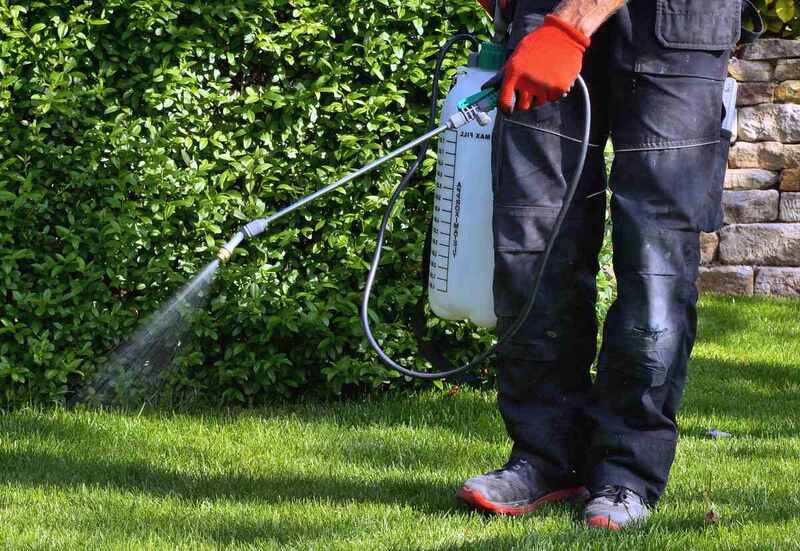
When weeds sprout in the lawn, homeowners’ first defense is often glyphosate or another common type of post-emergent herbicide. But with so many types on the shelf (and online), which one is best?
We’ll break down the types of post-emergent herbicides to make it easier to choose the right one for your lawn. We’ll discuss them in pairs: systemic vs. contact, selective vs. non-selective, and granular vs. liquid, highlighting important differences to help you decide which type will be most effective for your turf’s weeds.
What are Post-Emergent Herbicides?
Post-emergent herbicides are products that kill weeds that have already emerged from the soil and are actively growing. Homeowners use post-emergent herbicides to manage existing weeds in their lawns, landscaping beds, and gardens.
Post-emergent herbicides often work alongside pre-emergent herbicides, which are applied before weeds sprout. Pre-emergents create a barrier along the soil to prevent weeds from sprouting above the soil surface. But if you forgot to apply pre-emergent herbicides or still see a few weeds popping up, post-emergents are the product you’ll want to choose.
Note: The best time to spray weed killer is in the spring and fall when the weeds are still young and actively growing.
See Related: Applying Post-Emergent Herbicides to Your Lawn
Types of Post-Emergent Herbicides
With six major types of post-emergent herbicides available, you have several options for weed control in your yard. To help you choose the best herbicide for your needs, I will explain more about each of them, their pros and cons, and what they’re best used for.
Systemic vs. Contact Post-Emergent Herbicides

| Key Factors | Systemic | Contact |
| How it Works | Translocates to the roots, killing the above-ground foliage and the root system | Kills only the foliage it comes in contact with |
| How Fast it Works | Takes a few days to show effects | Works rapidly, with visible damage within hours to a few days |
| Type of Weed | Effective against perennial and annual weeds | Most effective for annual weeds; less effective against weeds with thick cuticles or hairy surfaces |
| Regrowth | Prevents regrowth by killing the roots | Requires multiple applications, but regrowth less likely for annuals; regrowth highly likely for perennials |
Systemic post-emergents use the process of translocation to kill weeds completely. Once weeds absorb it, its active ingredient moves through the vascular system and affects all parts of the plant, reaching down to its roots. When it reaches the root system, the weed is completely killed, preventing it from growing back again.
Contact post-emergents are fast-acting — they can damage plant tissues they come in contact with within a few hours to a few days. When applied to weeds, it damages the leaves and prevents them from being able to photosynthesize. With a severe lack of nourishment, the weeds quickly die.
Pro Tip: If you can wait to see results, systemic herbicides offer a comprehensive solution for eradicating weeds. But if you want fast, visible results or need to control annual weeds quickly, you can opt for contact herbicides.
Selective vs. Non-Selective Post-Emergent Herbicides
| Key Factors | Selective | Non-Selective |
| Precision | Kills specific weed species without harming other, non-target plants | Kills all plants it comes into contact with |
| Effectiveness | Requires multiple applications for best results | Can kill weeds in as little as one application |
| Cost | More expensive than non-selective | More cost-effective, especially for large-scale weed removal |
| Best Used For | Targeted weed control in lawns | Clearing large areas or removing weeds in driveways and patios |
Selective post-emergent herbicides are the right choice when you need to control weeds without harming the other plants, like grass, nearby. They are designed to kill only specific weeds. For instance, some formulas kill broadleaf weeds but do not harm grassy weeds like crabgrass and Bermudagrass. Check the label to buy the product formulated for your weeds.
Non-selective post-emergent weed killers are effective for killing all plants they come in contact with. For example, non-selective herbicides containing glyphosate (one of the most effective weed killer chemicals) can eradicate weeds with a single application. For this reason, non-selective herbicides are often used when killing lawns before planting grass seed.
Granular vs. Liquid Post-Emergent Herbicides

| Key Factors | Granular | Liquid |
| Application Method | Applied using a spreader | Applied using a sprayer |
| Coverage and Yard Size | Best for broad coverage across larger areas | Best for targeted coverage (spot treatments) across average-sized lawns |
| How Fast it Works | Slower than liquid, as it requires moisture to activate | Absorbed quickly, showing faster results |
| Precision | Harder to control distribution, leading to uneven application | Targeted spot treatment minimizes impact on surrounding plants |
| Shelf Life | Longer shelf life | Shorter shelf life |
Granular post-emergents, in solid pellet or granular form, don’t work as quickly as liquid formulas. Once spread on the soil, they must be activated through irrigation or rainfall, which breaks down and releases the active ingredients. Granular post-emergent products are less common than liquid post-emergents and are often included in “weed and feed” products.
Liquid post-emergents are fast-acting — ideal for spot treatments. For smaller applications, you can use a handheld sprayer to apply it directly onto the leaves of the weeds you want to eliminate. If you need to cover a larger area, you can invest in a backpack sprayer for faster application.
Pro Tip: If you want a fast-acting solution to the weeds in your lawn, a liquid post-emergent herbicide is your best bet.
Common Active Ingredients
Some of the common active ingredients included in post-emergent weed killers are as follows:
- Halosulfuron-methyl: It’s quite slow since it translocates within the plant. But it’s very effective and safe for turfgrass and ornamentals.
- Glyphosate: It prevents weeds from making amino acids, which is vital for plant growth and development.
- Glufosinate: Common in non-selective weed killers, it works faster than glyphosate.
- Pelargonic acid: This non-selective ingredient is used for broadleaf and grass control.
Choosing the Post-Emergent That’s Right for You

With so many different types, brands, and variations of herbicides available, figuring out which weed killer to use can take a while. Here’s a list of considerations to help you choose:
- Application setting: Not all weed killers are suitable for all your weed control needs. For example, non-selective herbicides will work for situations like land clearing. Check the information on the label to determine its best use.
- Operating method: Understand how herbicides work, so you can choose which one will work best. Some inhibit photosynthesis, while others disrupt cell membranes.
- Application method: Choose a weed killer you can apply easily. Consider your current equipment so you won’t have to buy something new.
- Cost and budget: The most affordable option is not always the best for effective control of your weed issues. Try to balance the cost-effectiveness and long-term benefits of the chosen product.
- Compatibility: To avoid side effects or reduced effectiveness, ensure the herbicide is compatible with other lawn care chemicals you’re currently using.
- Ecological footprint: Evaluate the environmental impact of the herbicide. Ensure it has low toxicity levels, reduced runoff potential, and minimal impact on water quality.
FAQ About Post-Emergent Herbicides
The main difference between them is that ready-to-use formulas are more convenient because all you have to do is apply them. On the other hand, concentrated formulas require mixing with water (dilution) as instructed by the label.
It depends on the herbicide. For example, contact post-emergents can take as little as a few hours to show results, while systemic post-emergents can take a few days to a week before you see results. However, other factors like the type of weed and the current weather also come into play.
Experts don’t recommend using post-emergent herbicide on new grass, as the chemicals may be too strong for the young grass. It’s always best to wait after the third or fourth mow, or as long as an entire growing season, before applying any weed killer.
No, post-emergent herbicides are not safe for pets if used improperly. In general, have your pets stay away from treated areas for a day or two or until fully dry. As always, follow the instructions on the label to keep your pets safe. If in doubt, extend the time you keep pets off the lawn after application or use pet-safe organic herbicides.
Yes, there are organic post-emergent herbicides, but they’re mostly non-selective. Most natural weed killers use vinegar, but there are other ways for you to make a homemade weed killer. For example, you can use boiling water or a weed torch for spot treatment.
Choose the Best Weed Killer for Your Lawn
Knowing the different types of post-emergent herbicides can help you decide the best option for controlling the weeds in your lawn. Consistent care is crucial, though. So, if you can’t spend time and effort on this task, hire a lawn care pro to keep your lawn weed-free and healthy.
Sources:
- Plant & Soil Sciences eLibrary: Translocation of Foliar-Applied Herbicides
- University of Georgia Extension: Weed Control in Home Lawns
- West Park Animal Hospital: Weed Killers and Your Pets
- University of Florida IFAS Extension: You Only Need Four Post-Emergent Herbicides
- University of California Integrated Pest Management: Herbicides – Weeds in Landscapes
Main Image Credit: New Africa / Adobe Stock